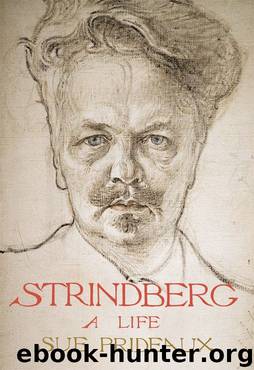Strindberg: A Life by Sue Prideaux

Author:Sue Prideaux [Prideaux, Sue]
Language: eng
Format: epub
Tags: Biography
ISBN: 9780300136937
Publisher: Yale University Press
Published: 2012-02-13T08:00:00+00:00
Before laughing at some of their more ludicrous attempts to catch the greased pig, one may remember that they were just a piece of the great jigsaw quest that some twenty years later resulted in the formation of the Vienna Psychoanalytical Society (1908) and the publication of Freud's major books on dreams and sexuality (1910). Ten year later still, came Jung's The Psychology of the Unconscious.
Inspired by all this scientific investigation, and nervous that he might need ‘a sideline to keep myself afloat for the time being’, Strindberg turned the kitchen of the Hanssons' flat into a darkroom and became obsessed with solving the problem of colour photography. He made his own camera from a cigar box and a piece of paper with a hole in it. A thirty-second exposure was just right. The colours, he found, had the obstructive habit of remaining invisible on the exposed plates but he was certain they were there. All that was needed was another experiment or two to make the breakthrough. ‘Developing with liquids must be the mistake’, he decided; ‘I shall now use gases!’19 But gases got him no further. He was building up quite a science lab in Laura Hansson's kitchen.
The same month he had arrived in Germany one of the popular celebrity scientists had given a lecture at a scientific congress in Berlin. Ernst Haeckel,20 the highly regarded Vice-President of the University of Jena, was a natural scientist who made it his mission to illustrate ‘nature's soul’, bringing the Divine back into Darwinism and the standards of beauty and symmetry found in classical sculpture and architecture to evolutionary biology. Haeckel built up his case by taking the recurring patterns in nature to construct a religious narrative of evolution. Nature as design became nature as designed. His enormously popular and beautifully illustrated books, The Natural History of Creation (1868), Monism as connecting Religion and Science (1892) and Art Forms in Nature (1899), revealed to readers the diversity of the world through the microscope. It was micro-cosmology, a journey into a world so exquisite that the readers who bought the books in their millions were comforted by the nobility of spirit conveyed by these hitherto unseen patterns in nature. Haeckel's illustrated books did much to inspire the organic nature-based forms of Art Nouveau and Jugendstil and they influenced Strindberg who began to call himself a Monist and painted emotionally charged paintings of patterns in nature, mostly trees, the sea and clouds. Haeckel also started Strindberg on a long road of scientific experiments concerning the elements. Haeckel's Monism proposed that there was no such thing as a chemical element, it being the nature of things that everything obeyed a natural cycle of birth, maturity, death and decay; elements were no exception to this rule. Elements were unstable and they might be unpicked by careful work in the laboratory. Strindberg began to try to unpick the element of sulphur in the Hanssons' kitchen.
Laura Hansson was not amused. Her husband had encouraged Strindberg to join
Download
This site does not store any files on its server. We only index and link to content provided by other sites. Please contact the content providers to delete copyright contents if any and email us, we'll remove relevant links or contents immediately.
Cecilia; Or, Memoirs of an Heiress — Volume 3 by Fanny Burney(31824)
Cecilia; Or, Memoirs of an Heiress — Volume 2 by Fanny Burney(31811)
Fanny Burney by Claire Harman(26509)
We're Going to Need More Wine by Gabrielle Union(18951)
Plagued by Fire by Paul Hendrickson(17314)
All the Missing Girls by Megan Miranda(15503)
Cat's cradle by Kurt Vonnegut(15156)
Bombshells: Glamour Girls of a Lifetime by Sullivan Steve(13953)
Leonardo da Vinci by Walter Isaacson(13150)
For the Love of Europe by Rick Steves(12674)
4 3 2 1: A Novel by Paul Auster(12263)
Adultolescence by Gabbie Hanna(8837)
The remains of the day by Kazuo Ishiguro(8791)
Note to Self by Connor Franta(7606)
Diary of a Player by Brad Paisley(7460)
Giovanni's Room by James Baldwin(7164)
What Does This Button Do? by Bruce Dickinson(6124)
Born a Crime by Trevor Noah(5278)
Ego Is the Enemy by Ryan Holiday(5268)
